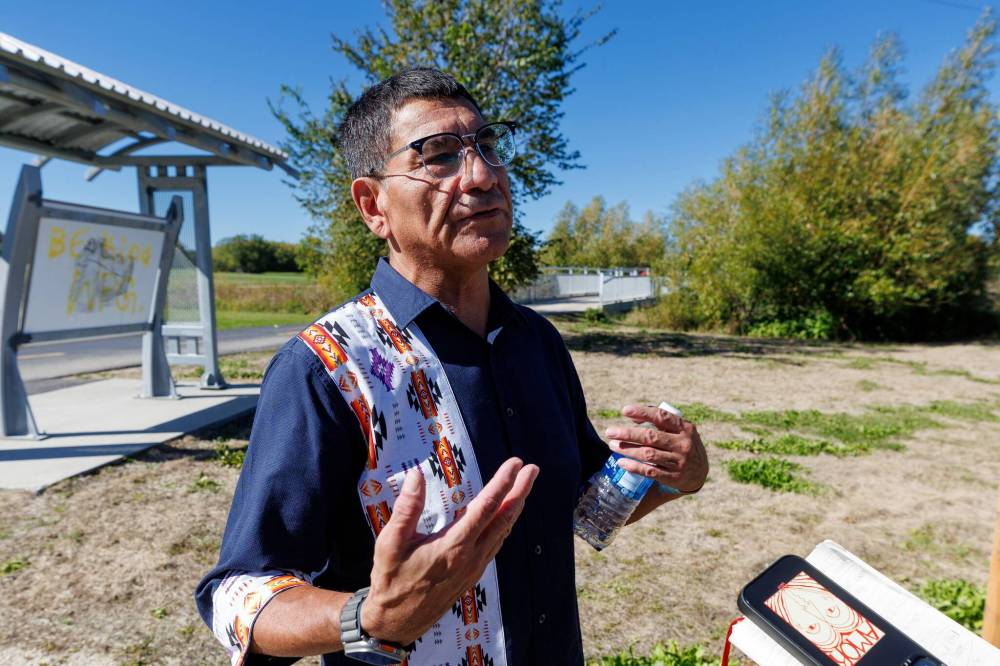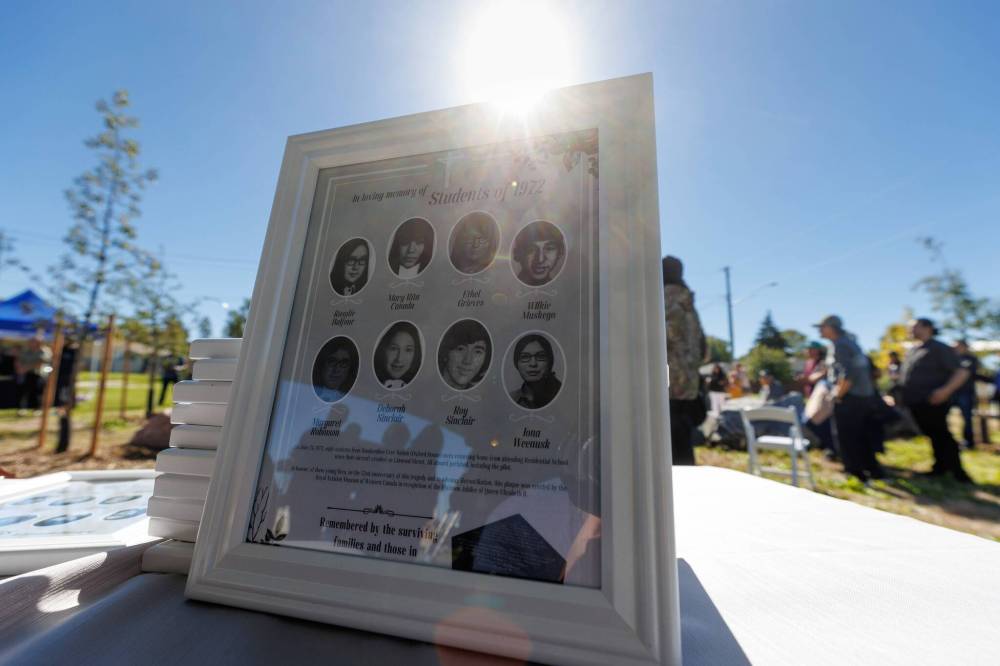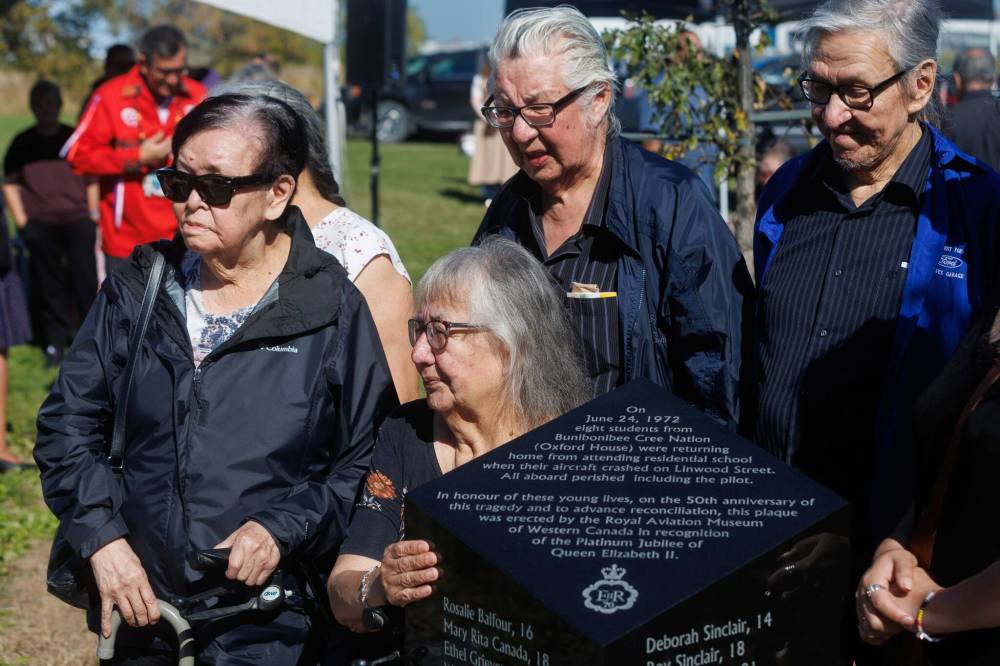On a sunny June afternoon in 1972, the Grieves family waited near the new runway in Bunibonibee Cree Nation for the return of daughter Ethel from school in Portage la Prairie for the summer.
Anostin Grieves, just eight years old, and his siblings were excited to welcome their sister, who always took toys home to Bunibonibee (Oxford House), using money she had earned while babysitting.
Hours went by without sight of the plane, which had eight young passengers from Winnipeg. Six were attending Stonewall Collegiate Institute and two students went to the Portage la Prairie residential school.

MIKE DEAL / FREE PRESS
Anostin Grieves talks about what the memorial means to him and the events surrounding the aftermath of the plane crash which happened when he was just eight years old.
“There was nobody that came. There was no plane,” Grieves recalled on Wednesday.
A radio report said that a plane had crashed. The family learned that shortly after takeoff, the Beechcraft-18 crashed into a vacant lot between two houses on Linwood Street in St. James.
The crash claimed the lives of Mary Rita Canada, 18, Wilkie Muskego, 16, Roy Sinclair, 16, Deborah Sinclair, 14, Iona Weenusk, 21, Margaret Robinson, 16, Rosalie Balfour, 16 and Grieves.
Wilbur Coughlin, the 47-year-old pilot from B.C., also died.
“I often wonder what she would have been like or what she would have done if it didn’t happen,” Grieves, now 60, said about his sister, who was 17 when the tragedy occurred.
“She was incredibly nice and kind… she would have gone beyond high school and done something great.”
On Wednesday, Indigenous leaders and dignitaries unveiled a monolith, etched with the names of the nine victims, in a park along the Yellow Ribbon Greenway Trail in Winnipeg, metres from where the aircraft went down on June 24, 1972.
Bunibonibee Chief Richard Hart described the event as the most devastating the community has faced.
“Our community was still quite small at the time and very isolated, and you can only imagine to lose eight young people like that,” Hart told the crowd. “We have never taken a break from honouring the lost youth.”

MIKE DEAL / FREE PRESS
A framed collection of the children who lost their lives during the unveiling of the historical marker commemorating the eight victims of the 1972 plane crash in Winnipeg.
A similar monument is in Portage la Prairie at the site of the former residential school attended by Grieves and Weenusk.
The idea for the Winnipeg monument came from the Royal Aviation Museum of Western Canada and Indigenous curator and Free Press columnist Niigaan Sinclair. Sinclair and museum CEO Terry Slobodian approached the city with the idea. After approval, the museum announced its construction in August 2022.
“We wanted to make sure that those lives will never, ever, ever be forgotten,” Slobodian said.
Mayor Scott Gillingham advocated for a monument in 2022 when he was councillor for the St. James ward.
The monument is also a symbol of the effects of residential schools, Gillingham said.
“It’s more than a story of a tragic plane crash. This is the story of Canada’s history. This is the story of residential schools. This is the story that must be told to future generations,” he said.
Grieves remembers his sister feeling “incredibly lonely” in residential school, which she had to attend because the community’s school went up to Grade 8.
Grieves recalls Ethel begging their parents to stay home after Christmas and summer breaks ended.

MIKE DEAL / FREE PRESS
Victims’ family members get their photos taken with the memorial after its unveiling Wednesday afternoon.
“I remember my dad standing over her saying, ‘You have to go back to school because you need to get ahead. You need to make a living,’” he said, tearing up at the memory.
The Truth and Reconciliation Commission confirmed 3,200 deaths as a result of the residential school system, but the true number is estimated to be more than seven times higher; others died travelling to or from school on planes, trains, buses, cattle cars and boats.
Grieves, who is a lawyer, hopes the monument will serve as a reminder of the system.
“The majority of people who live in this country are not aware of the history,” he said. “Had we not experienced the residential school system, we would still be owners of this land.”
nicole.buffie@freepress.mb.ca

Nicole Buffie
Multimedia producer
Nicole Buffie is a multimedia producer who reports for the Free Press city desk. Born and bred in Winnipeg, Nicole graduated from Red River College’s Creative Communications program in 2020 and worked as a reporter throughout Manitoba before joining the Free Press newsroom in 2023. Read more about Nicole.
Every piece of reporting Nicole produces is reviewed by an editing team before it is posted online or published in print — part of the Free Press‘s tradition, since 1872, of producing reliable independent journalism. Read more about Free Press’s history and mandate, and learn how our newsroom operates.
Our newsroom depends on a growing audience of readers to power our journalism. If you are not a paid reader, please consider becoming a subscriber.
Our newsroom depends on its audience of readers to power our journalism. Thank you for your support.